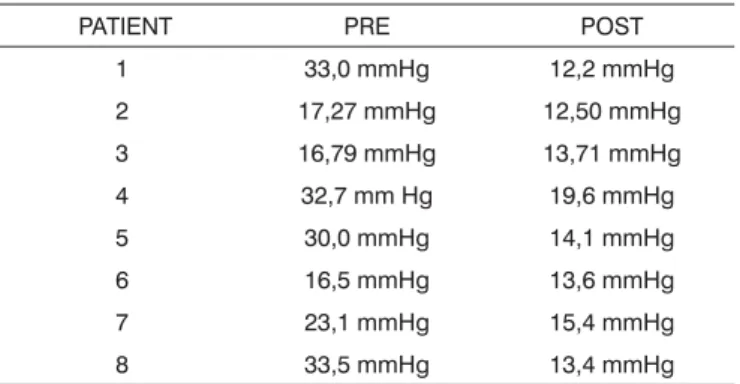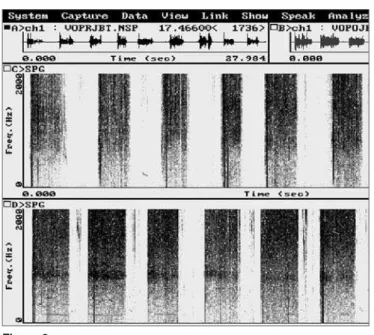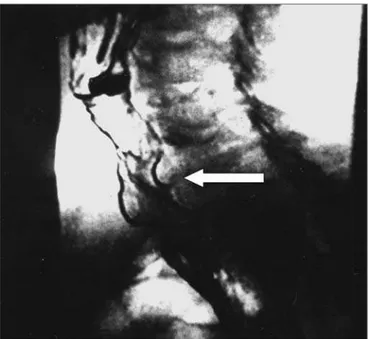Botulinum toxin in speech
rehabilitation with voice
prosthesis after total
laryngectomy
Summary
Carlos Takahiro Chone1, Cristiane Teixeira2, Nelson A. Andreollo3, Ana Lucia Spina4, Irene H.
K. Barcelllos5, Elizabeth Quagliato6, Agricio N. Crespo7
1 Doctor in medicine, specializing in Otorhinolaryngology, Medical School of the Campinas State University. Adjunct Professor / Otorhinolaryngology and Head & Neck
Discipline / Unicamp.
2 Otorhinolaryngologist, medical resident / Otorhinolaryngology and Head & Neck Discipline / Unicamp. 3 Adjunct professor, Gastric Surgery Discipline / Gastrocentro / Unicamp.
4 Doctoral student, Otorhinolaryngology and Head & Neck Discipline / Unicamp. Speech therapist/ Otorhinolaryngology and Head & Neck Discipline / Unicamp. 5 Adjunct professor / Radiology Department / Unicamp.
6 Adjunct professor / Neurology Departmento / Unicamp.
7 Adjunct professor / Otorhinolaryngology and Head & Neck Discipline / Unicamp. Chief of the Otorhinolaryngology and Head & Neck Discipline / Unicamp.
Otorhinolaryngology and Head & Neck Discipline / Unicamp.
Address for correspondence: Carlos T. Chone - Rua Zerillo Pereira Lopes 477 casa 33 Campinas São Paulo 13087-757.
Paper submitted to the ABORL-CCF SGP (Management Publications System) on January 15, 2007 and accepted for publication on April 5th, 2007. cod. 3604.
I
n tracheo esophageal puncture (TEP), we carry out a myotomy of the pharynx constrictor muscle; however, about 9 to 79% of patients need such procedure. The consequence of such procedure is an increase in salivary fistula rates in the postoperative. Botulin toxin is used in an outpatient basis. Aim: analyzing the efficacy of botulin toxin (BT) use in the rehabilitation of totally laryngectomized patients with tracheo-esophageal voice (TEV) with spasms (S) of the pharyngo-esophageal segment (PES) without myotomy. Materials and Methods: We analyzed eight patients submitted to total laryngectomy (TL), rehabilitated with TEV, with speech prosthesis (SP) and struggle to utter voice because of PES spasms. They were all submitted to treatment of such motor alteration with the injection of 100 units of BT in the PES. The evaluation was based on perceptive voice analysis, video fluoroscopy (VF) of the PES, acoustic voice analysis and computerized manometry (CM) of the PES, all before and after BT injection. Study design: prospective. Results: There was a reduction in PES CM pressure after BT injection. Acoustic analysis showed an improvement in harmonics quality after treatment. There was smoother voice utterance and spasm improvement after BT. Conclusion: all patients with PES spasms presented vocal improvement after BT injection in the PES.Keywords: laryngeal cancer, total laryngectomy, botulinum toxin, voice, head and neck, tracheoesophageal speech.
ORIGINAL ARTICLE
INTRODUCTION
About 9% to 79% of total laryngectomy (TL) pa-tients undergoing rehabilitation with tracheoesophageal voice (TEV), phonatory prostheses (PP), and primary or secondary tracheoesophageal needle puncture (TEP), present effort-induced phonatory difficulties associated with motility alterations in the pharyngoesophageal seg-ment (PES) secondary to spasm of this segseg-ment.1-13 There
are three approaches for the treatment of PES alterations: myotomy of the middle and lower constrictors of the pharynx, neurectomy of the pharyngeal plexus, and the recently described chemical denervation of the PES with the botulinum toxin (BT).6,7,8,10,11,14-23 The BT is a presynaptic
blocker of acetylcholine release at the neuromuscular junc-tion. Videofluoroscopy3,4,7,15,24 and computed manometry
(CM) demonstrate relaxation of the PES following the use of BT in this region. There are indirect assessment metho-ds of the PES pressure, such as the modified esophageal insufflation test,4,6,15 measurement of intratracheal pressure
and the phonation time.7,18 The purpose of this study was
to assess the efficacy of the BT in TL patients rehabilitated by TEV with PP that presented emission of voice under effort due to spasm of the PES.
MATERIAL AND METHOD
Eight TL patients rehabilitated by TEV with PP that presented excessive effort for voice emission and an almost absent maximum phonation time were selected from 71 TL patients that were similarly rehabilitated. All patients used an indwelling Blom-Singer (Inhealth®) PP, inserted after primary or secondary TEP.
The Research Ethics Committee of the local institu-tion approved this study (protocol number 546/2005). All patients signed a free informed consent form.
Testing was composed of perceptive voice analysis, measurement of the mean phonation time (mean of three consecutive measurements using a professional chrono-meter), swallowing and phonation testing by videofluo-roscopy, four-channel CM, and computed acoustic voice analysis before and after injecting 100U of BT (Botox®) in the site of pharyngospasm. All patients also complained of mild dysphagia. BT was injected in each third of the PES (Figure 1) under electromyographic control of the pharyngeal constrictor muscles.
RESULTS
CM revealed a decrease in the mean PES pressure following BT injection in eight patients (Table 1, Figure 2a and 2b).
Computed acoustic analysis demonstrated the pro-duction of harmonics after BT injection in the PES of eight patients (Figure 3a and 3b). Harmonics were absent in these patients prior to therapy. Effortless voice production
Figure 1. Representation of botulinum toxin injection areas in the three thirds of the pharyngoesophageal segment.
Table 1. Pharyngoesophageal segment pressure on computed manometry before (PRE) and after (POST) application of 100 U of the botulinum toxin.
PATIENT PRE POST
1 33,0 mmHg 12,2 mmHg
2 17,27 mmHg 12,50 mmHg
3 16,79 mmHg 13,71 mmHg
4 32,7 mm Hg 19,6 mmHg
5 30,0 mmHg 14,1 mmHg
6 16,5 mmHg 13,6 mmHg
7 23,1 mmHg 15,4 mmHg
8 33,5 mmHg 13,4 mmHg
and increased phonation time became possible in these patients (Table 2). Before BT therapy, the phonation time in all patients was one second. All patients reported im-proved voice quality, as was demonstrated by the voice perception analysis. Videofluoroscopy of the PES during phonation showed that spasm of the PES decreased (Fi-gure 4a and 4b). There were no adverse effects caused by the BT. There was clinical improvement of dysphagia in all patients.
Figure 2. Pressures in the pharyngoesophageal segment for each computed manometry channel before (a) and after (b) application of the botulinum toxin. Each baseline is one channel. Arrows on each baseline show the pharyngoesophageal pressure.
Figura 3a.
Figure 3. Computed acoustic analysis before (a) and after (b) injecting the botulinum toxin in the pharyngoesophageal segment. Harmonics were present after botulinum toxin injection (b), not visible before. An arrow shows a harmonic.
Table 2. Mean phonation time values, in seconds, before (PRE) and after (POST) application of 100 units of the botulinum toxin in the pharyngoesophageal segment.
Patient
Phonation time, in
seconds PRE POST
1 1,0 9,0
2 1,0 7,0
3 1,0 7,0
4 1,0 7,5
5 1,0 8,0
6 1,0 8,5
7 1,0 6,8
8 1,0 7,0
DISCUSSION
PES spasm is one of the causes of failure in the rehabilitation of TL patients with TEV and PP.1-13 Altered
PES motor activity in these cases is a reflex initiated by air entering the esophagus, blocking air from progressing to the pharynx. Consequently, the pharyngeal mucosa does not vibrate, and there is no phonation.1,3-5,7-9,13,18 Spasm may
be seen in videofluoroscopy done during phonation with the PP;5,7,8,15,24 it is absent during swallowing when the PES
relaxes. During constriction there is no relaxation when swallowing. In this case, therapy is dilatation.4,5,24 These are
reflux; in TL patients, however, they become an obstacle against phonatory rehabilitation.7,8,13,24
BT injected in the PES was initially described in 199425 for the treatment of swallowing disorders in which
there was a hypertrophic or hypertonic upper esophageal sphincter. The dosages were 80 to 120 units. This method was first described for the treatment of PES spasm after
TEP with PP in 1995.15 Some authors have shown effects
lasting up to 2 years and 3 months with one initial dose only.17 A possible explanation for this is that after the first
dose, patients adapt to the new condition;17 alternatively,
denervation of the pharyngeal constrictor muscles due to presynaptic block by the BT might occur.
In primary TEP, myotomy of the middle and infe-rior pharyngeal constrictor muscles is one of the surgical steps.10,26 This step may be related to a higher incidence of
postoperative salivary fistulae.12,26 In such cases, hospital
stay and medical expenses are increased, and phonatory rehabilitation, oral feeding and even the beginning of postoperative radiotherapy are delayed. The true need for myotomy in TEP is a controversial issue in the literature, varying from 9% to 79% in TL patients.1-13 In secondary
TEP, myotomy is associated with a 10% to 20% incidence of salivary fistulae,26 with the same consequences
mentio-ned above. Using the BT for the treatment of PES spasm makes it possible to restrict myotomy for those patients that truly require this method for treating the PES; this avoids unnecessary procedures in the remaining patients, and reduces their surgery time and complication rate. Injection of the BT is done in an outpatient setting; the patient is seated and awake, and under electromyogra-phic monitoring of the pharyngeal constrictor muscles. This procedure is less expensive than myotomy of the pharyngeal constrictor muscles.17 It should be borne in
mind that even after myotomy of the middle and lower pharyngeal constrictor muscles, there may be spasm by reapproximation of muscle fibers.1,7,10,11,17 In such cases,
the BT may also be used.
CONCLUSION
The BT effectively decreased PES pressure in all patients, as assessed by CM.
All patients were able to produce harmonics follo-wing application of the BT in the PES, as demonstrated by computed acoustic voice analysis.
Phonation time was increased in all patients follo-wing application of the BT.
After injection of the BT, spasm of the PES decreased in all patients, as confirmed by videofluoroscopy.
REFERENCES
1. Lavertu P, Guay ME, Meeker SS, Kmiecik JR, Secic M, Wanamake JR, Eliachar I, Wood BG. Secondary tracheoesophageal puncture: factors predictive of voice quality and prosthesis use. Head Neck 1996;18:393-8.
2. Blom ED, Pauloski BR, Hamaker RC. Functional outcome after surgery for prevention of pharyngospasms in tracheoesophageal speakers. Part I: Speech characteristics. Laryngoscope 1995;105: 1093-103. 3. Sloane PM, Griffin JM, O’Dwyer TP. Esophageal insufflation and
vi-deofluoroscopy for evaluation of esophageal speech in laryngectomy patients: clinical implications. Radiology 1993;181:433-7.
Figure 4a.
4. Singer MI, Blom ED. An endoscopic technique for restoration of voice after laryngectomy. Ann Otol Rhinol Laryngol 1980,89:529-33. 5. Blom ED, Singer MI, Hamaker RC. An improved esophageal
insu-fflation test. Arch Otolaryngol 1985;111:211-2.
6. Blom ED, Singer MI, Hamaker RC. A prospective study of tracheoeso-phageal speech. Arch Otolaryngol Head Neck Surg 1986;112:440-7. 7. Singer MI, Blom ED. Selective myotomy for voice restoration after
total laryngectomy. Arch Otolaryngol 1981;107:670-3.
8. Singer MI, Blom ED, Hamaker RC. Pharyngeal plexus neurectomy for alaryngeal speech rehabilitation. Laryngoscope 1986;96:50-3. 9. Callaway E, Truelson JM, Wolf GT, Kincaid LT, Cannon S. Predictive
value of objective esophageal insufflation testing for acquisition of tracheoesophageal speech. Laryngoscope 1992;102:704-8.
10. Hamaker RC, Singer MI, Blom ED, Daniels HA. Primary voice resto-ration at laryngectomy. Arch. Otolaryngol 1985;111:182-6.
11. Yoshida GY, Hamaker RC, Singer MI, Blom ED, Charles GA. Prima-ry voice restoration at laPrima-ryngectomy: 1989 update. LaPrima-ryngoscope 1989;99:1093-5.
12. Lau WF, Wei WI, Ho C M, Lam KH. Immediate tracheoesophageal puncture for voice restoration in laryngopharyngeal resection. Am J Surg 1988:156:269-72.
13. Stiernberg CM, Bailey BJ, Calhoun KH, Perez DG. Primary tracheoe-sophageal fistula procedure for voice restoration: The University of Texas medical branch experience. Laryngoscope 1987;97:820-4. 14. Baugh RF, Lewis JS, Baker SR. Vocal rehabilitation of
tracheoesopha-geal speech failures. Head Neck 1990;12:69-73.
15. Blitzer A, Komisar A, Baredes S, Brin MF, Stewart C. Voice failure after tracheoesophageal puncture: management with botulinum toxin. Otolaryngol Head Neck Surg 1995;113:668-70.
16. Crary MA, Glowalski AL. Using botulinum toxin A to improve speech and swallowing function following total laryngectomy. Arch Otola-ryngol Head Neck Surg 1996;122:760-3.
17. Hoffman HT, Fischer H, Vandenmark D, Peterson KL, Mcculloch TM, Karnell LH, Funk GF. Botulinum toxin injection after total laryngec-tomy. Head Neck 1997;19:92-7.
18. Mahieu HF, Annyas AA, Schutte HK, Jagt EJ Van Der. Pharyngo-esophageal myotomy for vocal rehabilitation of laryngectomees. Laryngoscope 1987;97:451-7.
19. Terell JE, Lewin JS, Esclamado R. Botulinum toxin injection for pos-tlaryngectomy tracheoesophageal speech failure. Otolaryngol Head Neck Surg 1995;113:788-91.
20. Zormeier MM, Meleca RJ, Simpsom ML, Dworkin JP, Klein R, Gross M, Mathog D. Botulinum toxin injection to improve tracheoesopha-geal speech after total laryngectomy. Otolaryngol Head Neck Surg 1999;120:14-9.
21. Hamaker RC, Blom ED. Botulinum neurotoxin for pharyngeal constrictor muscle spasm in tracheoesophageal voice restoration. Laryngoscope 2003;113:1479-82.
22. Chone CT, Spina AL, Crespo AN, Gripp FM. Speech rehabilitation after total laryngectomy: long-term results with indwelling voice prosthesis. Blom-Singer. Rev Bras Otorrinolaringol (Engl Ed) 2005;71:504-9. 23. Chone CT, Gripp FM, Spina AL, Crespo AN. Primary versus
secon-dary tracheoesophageal puncture for speech rehabilitation in total laryngectomy: long-term results with indwelling voice prosthesis. Otolaryngol Head Neck Surg 2005;133:89-93.
24. McIvor J, Evans Pf, Perry A, Cheesman Ad. Radiological assessment of post laryngectomy speech. Clin Radiol 1990;41:312-6.
25. Schneider I, Thumfart WF, Pototschhnig C, Eckel HE. Treatment of dysfunction of the cricopharyngeal muscle with botulinum A toxin: introduction of a new, noninvasive method. Ann Otol Rhinol Laryngol 1994;103:31-5.


